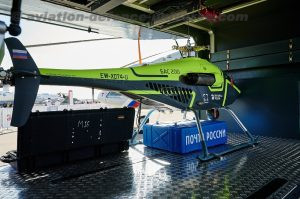Moscow. 21 May 2022. Russian Helicopters Holding Company of the Rostec State Corporation presented ambulance and business versions of the Ansat helicopter and unmanned aerial system BAS-200 at the International Helicopter Industry Exhibition HeliRussia 2022.

Participants and guests of the exhibition had an opportunity to see the modernized Ansat in an ambulance version, as supplied for the National Air Ambulance Service (NSSA). The helicopter is now fitted with a “glass cockpit” electronic display system. Integrated onboard radio-electronic equipment is produced by the Concern Radio-Electronic Technologies. The Ansat cabins were prepared for the installation of medical modules. These aircraft are designed to transport one patient accompanied by two medical specialists.
First modernized Ansat ambulances for NSSA are on duty in Tambov, Tula, Ryazan, Beslan, Novosibirsk, Samara and other cities and regions. Due to the short takeoff preparation time important for emergency medevac the Ansat is an efficient air ambulance.
Kazan Helicopter Plant and NSSA have signed contracts for 66 helicopters at the MAKS-2021 air show. As of today the Medical Service of Rostec has received 24 helicopters (14 Ansats and 10 Mi-8), with a total of 66 aircraft to be delivered: 29 Mi-8MTV-1 and 37 Ansats. The development of the regional air ambulance service is part of the Health Care National Project.
Another exhibit is Ansat Aurus, a certified version of the premium Ansat helicopter. The first Ansat Aurus has already been used for business flights at official events.
Ansat Aurus Design project was created by specialists of FSUE “NAMI”, the leading Russian scientific organization specializing in automotive development, the developer and manufacturer of the Aurus luxury cars brand.
The unmanned helicopter-based aerial system BAS-200 presented at the exhibition is suitable for a wide range of operations: area monitoring, cargo delivery, search and rescue missions and agricultural work. The maximum takeoff weight of the drone is 200 kilograms. It can speed up to 160 km/h and carry a payload of up to 50 kg. At the same time, the BAS-200 is capable of flying up to 4 hours at altitudes up to 3900 meters.
BAS-200 is currently undergoing a cycle of flight tests. The aircraft is adapted to different weather conditions. A series of test flights were conducted in December 2021, during which an airborne gravity survey using a UAV was performed for the first time. The tests were conducted jointly with the specialists of Aerogeophysica and Gazpromneft R&D center and confirmed the general possibility of performing airborne gravity measurements with the new generation of airborne gravity meters using UAVs as carriers.
The development of the BAS-200 project and flight tests of the UAV are conducted by the Mil and Kamov National Center for Helicopter Engineering. As part of the HeliRussia 2022 business program the Mil and Kamov specialists will hold the conference “Regional demand priorities for the UAVs application: Cases and prospects” to discuss possible applications of UAVs, priorities, and market demand for unmanned aerial vehicles.
































































































































